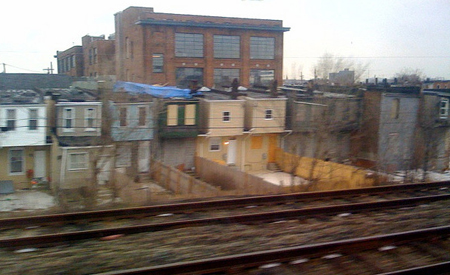
Out of the Ruins: The Wire’s Baltimore
Sarah Bernstein, Experience Congress 2011
McMaster University PhD candidate Sarah Trimble’s paper, “Body-More, Murdaland: Geographies of Gender, Race, and Capital in HBO’s The Wire,” reads the show’s Baltimore, Maryland as a space of becoming.
Trimble begins with a discussion of The Wire’s second season, which opens with the discovery of thirteen Jane Does in a shipping container in the Baltimore harbor. The port, in its last stages of physical and economic decay, becomes a site of convergence for space and flesh. Jump cuts create visual proximities between the embodied vulnerability of trafficked female bodies and the death of work for white, working-class men.
As trafficked bodies, the Jane Does act as economic supplements to working-class labour, while representing, at the same time, the eclipse of the working-class labour sector. The Jane Does also suggest a “feminization” of work – serving as a reminder that the labour market has shifted in favour of the service industry.
In this way, Trimble sees The Wire playing with the long (think Imperial) history of gendering and racializing places. Anxieties about a precarious global economy are displaced onto a feminized, unruly inner city – an apocalyptic vision of sorts.
Contemporary preoccupations with an apocalyptic vision, says Trimble, are inexorably tied to a specific moment in neo-liberalism. In apocalypse narratives, the ruined or “unruly” city becomes a place of anchor for the new, penetrable and easily-policed world. For Trimble, who is interested in finding other ways to read apocalyptic narratives, The Wire’s ruined Baltimore develops and rebuilds at the same time as it fissures to reveal the displaced, invisible bodies – the “collateral damage” (incidentally, also the title of the season’s fifteenth episode) of this economic development.
Survivalist readings of apocalyptic narratives amount to a “reconstituting [of] the family around a patriarchal model,” Trimble says. Finding an alternative reading, she feels, is ethically important. “I was interested in the suppressed alternative, what happens to women and children in the apocalyptic vision.”
Trimble sees The Wire as exploring the “condition that we live in”: the ways in which city-dwellers inherit proximities and fields of possibility from the city’s “spaces that open and close. Histories get materialized in our lives and bodies,” she says. The city-space offers a “spectrum of futures.”
The Wire’s apocalyptic Baltimore is not just a ruin out of which something can be built; it is a site of excavation where visions and memories themselves resonate.
Photo courtesy hirejoejohnson at Flickr













